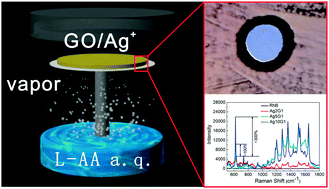Environmentally friendly synthesis of graphene–silver composites with surface-enhanced Raman scattering and antibacterial activity via reduction with l-ascorbic acid/water vapor†
Abstract
A green approach to the preparation of reduced graphene oxide (RGO) films has been developed using L-ascorbic acid/water vapor as the reducing agent. Except for the use of gaseous hydrazine hydrate or hydroiodic acid, this is the first reported use of an environmentally friendly gaseous phase for the reduction of graphene oxide (GO) films into RGO films. The as-prepared RGO films were flexible and showed a high electrical conductivity of up to 3500 S m−1. The L-ascorbic acid/water vapor was able to penetrate into the GO films and reduce the Ag ions. The as-reduced RGO–Ag composite films could be used as effective surface-enhanced Raman scattering active substrates and the Raman signals could be adjusted by changing the amount of Ag ions. The RGO–Ag composites also showed antibacterial activity against Escherichia coli, Staphylococcus aureus and white rot fungi. This is a straightforward and green approach to fabricating RGO–Ag composites for use in biological applications and materials science.


 Please wait while we load your content...
Please wait while we load your content...